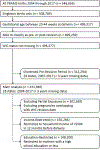The effect of the 2009 WIC revision on maternal and child health: A quasi-experimental study
- PMID: 35871753
- PMCID: PMC9588600
- DOI: 10.1111/ppe.12898
The effect of the 2009 WIC revision on maternal and child health: A quasi-experimental study
Abstract
Background: The Special Supplemental Nutrition Program for Women, Infants, and Children (WIC) is the largest U.S. nutrition program for low-income pregnant women. It was revised in 2009, with the goal of improving nutritional content of food packages, enhancing nutrition education, and strengthening breast feeding support. Few studies have assessed the effects of this revision on perinatal health.
Objectives: To investigate the impact of the revised WIC program on maternal and child health in a large, multi-state data set.
Methods: We conducted a quasi-experimental difference-in-differences analysis, comparing the pre/post changes among WIC recipients to changes among non-recipients. We adjusted for key sociodemographic covariates in multivariable linear models. We used data from the Pregnancy Risk Assessment Monitoring System (PRAMS) for 18 states from 2004 to 2017.
Results: The main analysis included 331,946 mother-infant dyads. WIC recipients were more likely to be younger, Black or Hispanic/Latina, unmarried, and of greater parity. The revised WIC program was associated with reduced likelihood of more-than-recommended GWG (-1.29% points, 95% confidence interval [CI] -2.03, -0.56) and increased likelihood of ever breast fed (1.18% points, 95% CI 0.28, 2.08). We also identified heterogeneous effects on GWG, with more pronounced associations among women 35 and older. There were no associations with foetal growth.
Conclusions: The revised WIC program was associated with improvements in women's gestational weight gain and infant breast feeding.
Keywords: PRAMS; United States; WIC program; infant health; maternal health; nutrition during pregnancy; policy analysis; quasi-experimental studies.
© 2022 John Wiley & Sons Ltd.
Conflict of interest statement
Figures
Comment in
-
WIC benefits and evaluation challenges.Paediatr Perinat Epidemiol. 2022 Nov;36(6):861-862. doi: 10.1111/ppe.12913. Epub 2022 Jul 13. Paediatr Perinat Epidemiol. 2022. PMID: 35830298 Free PMC article. No abstract available.
Similar articles
-
Association of Revised WIC Food Package With Perinatal and Birth Outcomes: A Quasi-Experimental Study.JAMA Pediatr. 2019 Sep 1;173(9):845-852. doi: 10.1001/jamapediatrics.2019.1706. JAMA Pediatr. 2019. PMID: 31260072 Free PMC article.
-
Georgia's breastfeeding promotion program for low-income women.Pediatrics. 2000 Jun;105(6):E85. doi: 10.1542/peds.105.6.e85. Pediatrics. 2000. PMID: 10835098
-
Eligibility and enrollment in the Special Supplemental Nutrition Program for Women, Infants, and Children (WIC)--27 states and New York City, 2007-2008.MMWR Morb Mortal Wkly Rep. 2013 Mar 15;62(10):189-93. MMWR Morb Mortal Wkly Rep. 2013. PMID: 23486384 Free PMC article.
-
Effects of the revised WIC food package on women's and children's health: a quasi-experimental study.BMC Pregnancy Childbirth. 2022 Nov 2;22(1):806. doi: 10.1186/s12884-022-05116-w. BMC Pregnancy Childbirth. 2022. PMID: 36324108 Free PMC article.
-
Savings achieved by giving WIC benefits to women prenatally.Public Health Rep. 1995 Jan-Feb;110(1):27-34. Public Health Rep. 1995. PMID: 7838940 Free PMC article. Review.
Cited by
-
Community-based diet and obesity-related policy, system, and environmental interventions for obesity prevention during the first 1000 days: A scoping review.Obes Rev. 2024 Nov;25(11):e13815. doi: 10.1111/obr.13815. Epub 2024 Aug 19. Obes Rev. 2024. PMID: 39159998 Free PMC article.
-
Impact of the 2009 WIC revision on infant and maternal health: A quasi-experimental multi-state study.Soc Sci Med. 2025 May;373:117974. doi: 10.1016/j.socscimed.2025.117974. Epub 2025 Mar 20. Soc Sci Med. 2025. PMID: 40168835
-
Effectiveness of the support program of providing food baskets for needy undernourished pregnant and lactating mothers in Iran: a case study of population level intervention.BMC Pregnancy Childbirth. 2025 Jul 2;25(1):687. doi: 10.1186/s12884-025-07764-0. BMC Pregnancy Childbirth. 2025. PMID: 40604552 Free PMC article.
-
Do studies evaluating early-life policy interventions fully adhere to the critical conditions of difference-in-differences? A systematic review.BMJ Open. 2024 May 16;14(5):e083927. doi: 10.1136/bmjopen-2024-083927. BMJ Open. 2024. PMID: 38760036 Free PMC article.
-
WIC benefits and evaluation challenges.Paediatr Perinat Epidemiol. 2022 Nov;36(6):861-862. doi: 10.1111/ppe.12913. Epub 2022 Jul 13. Paediatr Perinat Epidemiol. 2022. PMID: 35830298 Free PMC article. No abstract available.
References
-
- Siega-Riz AM, Viswanathan M, Moos M-K, Deierlein A, Mumford S, Knaack J, et al. A systematic review of outcomes of maternal weight gain according to the Institute of Medicine recommendations: birthweight, fetal growth, and postpartum weight retention. American Journal of Obstetrics and Gynecology 2009;201:339.e1–14. - PubMed
-
- Barker DJ. Maternal nutrition, fetal nutrition, and disease in later life. Nutrition (Burbank, Los Angeles County, Calif.) 1997;13:807–813. - PubMed
-
- Wu G, Bazer FW, Cudd TA, Meininger CJ, Spencer TE. Maternal nutrition and fetal development. The Journal of Nutrition 2004;134:2169–2172. - PubMed
-
- Painter RC, Roseboom TJ, Bleker OP. Prenatal exposure to the Dutch famine and disease in later life: an overview. Reproductive Toxicology (Elmsford, N.Y.) 2005;20:345–352. - PubMed


